Because the internet doesn’t have nearly enough opinions about Sword Art Online, I’ve done you all a favor and thrown my hat in as well. But seriously, above all the flame wars, there is always something to be said about this franchise.
Title: Sword Art Online II
Original airing: Jul 5, 2014 to Dec 20, 2014
Studio: A-1 Pictures
Episodes: 24
Duration: 23 min/episode
Genres: Action, Adventure, Fantasy, Game
Source: Sword Art Online Light Novel by Reki Kawahara
Where I watched: Netflix
Brief Synopsis and First Impressions
A year after escaping Sword Art Online, Kazuto Kirigaya has been settling back into the real world. However, his peace is short-lived as a new incident occurs in a game called Gun Gale Online, where a player by the name of Death Gun appears to be killing people in the real world by shooting them in-game. Approached by officials to assist in investigating the murders, Kazuto assumes his persona of Kirito once again and logs into Gun Gale Online, intent on stopping the killer.
Once inside, Kirito meets Sinon, a highly skilled sniper afflicted by a traumatic past. She is soon dragged in his chase after Death Gun, and together they enter the Bullet of Bullets, a tournament where their target is sure to appear. Uncertain of Death Gun’s real powers, Kirito and Sinon race to stop him before he has the chance to claim another life. Not everything goes smoothly, however, as scars from the past impede their progress. In a high-stakes game where the next victim could easily be one of them, Kirito puts his life on the line in the virtual world once more.
credit: MyAnimeList.net
I would normally fill this section with some background on why I chose to watch the show I’m reviewing, but the reason is pretty simple this time around. Whatever else interested me about this anime, the main reason I decided to include it this year was because I watched, and reviewed, the first Sword Art Online.
Of course, I don’t pick up every sequel. I did so with Noragami and Tokyo Ghoul since they were not complete without second seasons. I also watched Black Butler II, simply because the first captivated me. I chose to skip Psycho Pass 2, mostly due to mediocre reviews, and Magi: Kingdom of Magic because I was relatively disenchanted after the first.
Even though I’m ambivalent when it comes to Sword Art Online, there’s something about it that demands attention. Fans and haters alike tune in, if only to see what makes this series so polarizing. As predicted, SAO II was much the same, in content and reception, as season one. Still, there were a few conspicuous differences that elevated my appreciation for the series.
*This review will contain some spoilers from SAO; I can’t discuss SAO II properly without revealing details about the previous series.
Story

The events of Sword Art Online II take place a year after the first series ends. Viewers who saw the first season may recall how the Aincrad arc set up the events for the Fairy Dance arc to follow. Though SAO II also has a few consecutive arcs, they do not lead into one another. Because of this, it will make more sense if they are explained separately.
Phantom Bullet
With the spread of the VRMMO development software, ‘The Seed’ (given to Kirito at the end of season one), virtual games have begun to thrive. One of the most popular is Gun Gale Online (GGO); a Sci-Fi based game that emphasizes PVP and gun combat scenarios. A big part of its appeal are the highly anticipated Bullet of Bullets tournaments (BoB). BoB pits 30 finalists against one another to compete for special in-game items or currency; which can be converted to real cash.
Since GGO is played through the AmuSphere system, equipped with updated safety features, in-game death should no longer be a real life threat. But when players begin dying for real after being shot in-game, Kazuto is asked to investigate the situation. In order to observe “Death Gun,” the player rumored to be responsible for the murders, Kazuto must transfer his avatar, Kirito, to GGO. Along with his new androgynous avatar, Kirito has a few disadvantages. He isn’t familiar with the mechanics of GGO, nor did the items and skills obtained in previous games transfer over. With the help of Sinon, a female GGO player who mistakes Kirito for another girl, he joins the BoB tournament in hopes of uncovering Death Gun’s identity.

This game takes a different approach than SAO by acting more as a first person shooter than a MMORPG. The dynamics of GGO necessitate a different play style than Kirito is used to, though that doesn’t stop him from being the only player in the game to select a sword (lightsaber, really) as his weapon. It’s intriguing to witness Kirito strategize over how to take advantage of the game as it showcases a more deliberate approach to overcoming his challenges than sheer luck or overpowered skills.
While the tournament is essentially a ‘free for all,’ most fights end up being one-on one. This makes the confrontation between Kirito and Death Gun that much more intense. Unlike his battles against previous enemies, Kirito knows next to nothing about this new foe. In order to determine the nature of Death Gun’s lethal ability and save players’ lives, he must painstakingly piece together clues. When Sinon becomes the latest target, Kirito’s success becomes all the more vital. This cat and mouse game is made all the more personal when Kirito realizes that he and Death Gun may have a shared history as SAO survivors. The arc thus plays out as much like a detective drama as it does a high stakes action series.
Calibur
This arc unfolds in the ALO realm, with a quest to find Excalibur (the legendary sword used by Oberon during his duel with Kirito). Since Kirito and Leafa failed to defeat the dungeon guardian a year earlier, the group of friends form a party in hopes of working together to retrieve the sword. To their dismay, other players have already discovered Excalibur through another quest. After determining the quest is actually a façade invented by the Frost Giant King to wage war against the fairy realm, the event quickly turns into something far bigger.
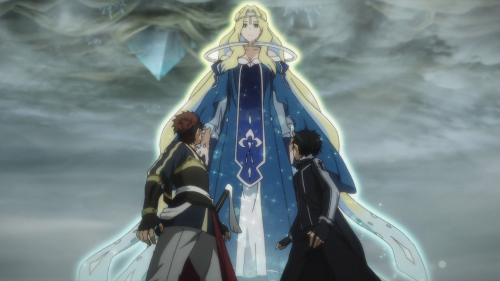
Encompassing a mere three episodes, this simplistic thread is little more than a dungeon crawl meant to reestablish some of the Fantasy RPG elements, and characters, sidelined during the GGO arc. The main difference is the shift in story focus. SAO is infamous for ‘characters not named Kirito’ getting glossed over. This arc instead stresses the team dynamic which gives the individual characters a chance to showcase their skills. Klein, Lisbeth and Silica, from season one, are more immersed in the action scenes this time around. Finally, those who worry about Asuna being relegated to back line support as a healer will be surprised by her versatile skillset.
Mother’s Rosario
Though this arc continues the adventures in ALO, real life concerns begin to play a bigger role. Asuna must deal with her mother’s demands for her to transfer to another school; in the interest of furthering her education and meeting potential ‘well-bred’ suitors. This leaves her faced with being torn away from her friends, her school, and Kazuto. Despite threats of being forbidden to play the game, Asuna continues to test her mother’s patience.
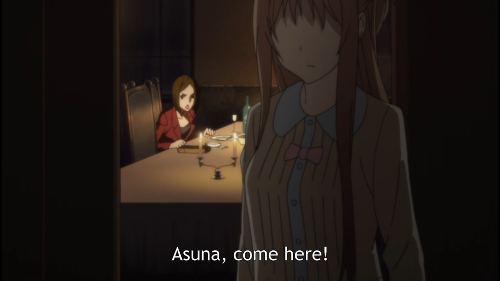
She allows her friends to coax her into attending a highly anticipated open duel challenge issued by another ALO player, “Zekken” (meaning Absolute Sword). Zekken’s challenge proposes that anyone who is skilled enough to beat them in combat will be taught their unique 11-strike sword skill, the most powerful move in the game. With all her friends, including Kirito, failing to defeat this powerful player, Asuna decides to accept Zekken’s challenge. It isn’t long into the match before she realizes the purpose of this duel is more than a prideful display of skill. Asuna’s experiences in the duel’s aftermath would change her life and give her the courage to stand up for what she desires most.
Mother’s Rosario can be viewed as another gradual shift away from the prior season. In the final episodes of SAO II, Kirito is no longer the central focus of the series and is designated to more of a supporting role. By highlighting Asuna in the latter episodes, the audience is able to witness how she adapts to tense situations without Kirito’s aid. Furthermore, the episodes involving her family explore how the game conflicts with real-life priorities. Though the blurred lines between games and real life was touched upon in season one, during the Fairy Dance arc, these final episodes of SAO II take it to an entirely different level. This final arc (to date) is a testament to the escapism that Virtual Reality provides. Though the real world is riddled with problems and limitations, this alternate existence gives people experiences they might never otherwise get the chance to have.
Characters

Along with the cast of friends from season one of SAO, a few characters have been added to help drive the major arcs. Early in season two, as the world of GGO unfolds, viewers are introduced to Sinon. This gun wielding avatar is controlled by Shino Asada – a timid girl often subjected to bullying. Additionally, Shino suffers from post traumatic stress disorder (PTSD), due to a gun related crime from her childhood. Though the experience causes her to panic over the very sight of a gun, the trauma becomes a driving force for her character.
This portrayal goes back to a concept explored early on in SAO: the difference between perceived strength in game and actual strength. Though Shino is able to control a fierce, adept sniper in GGO, the trauma she suffers in real life is nearly debilitating. A few times, this real life fear spills over into the game. For example, Shino suffers a panic attack when she encounters a player who wields the same model of gun as the assailant she encountered in her youth. This leads to her depending on Kirito for safety and to help her overcome her very real fears.
Another new, albeit ambiguous, character is Yuuki Konno. Taking Asuna’s depiction of a capale female character a step further, Yuuki appears as a scrappy fighter who faces her challenges and doesn’t let anyone else hold her back. Without spoiling key details, this character is a prime example of how a relentless drive towards accomplishing a goal can inspire others to do the same. A rival to Kirito in terms of game skill, Yuuki becomes a worthy substitute in his absence.
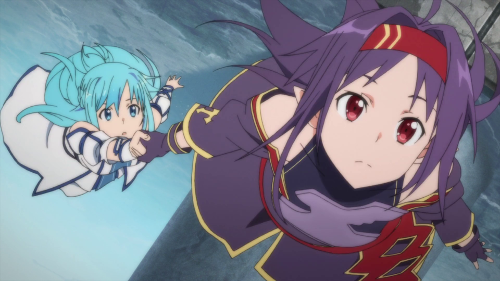
These details aside, Yuuki is woefully underdeveloped as a character. With only seven episodes to introduce her and wrap up season 2, it’s difficult to flesh her out in a natural manner. The series ends up having to be a little blunt instead, answering the questions about her character in a very straightforward way. The short span devoted to her development unfortunately doesn’t allow viewers the opportunity to become sufficiently invested in her arc. Individual results may vary, but Asuna’s attachment to her can feel forced if the audience doesn’t similarly sympathize.
Where Asuna herself is concerned, Sword Art Online II is both a redemption of her portrayal in the original series and a confirmation of who she is as a character. Sidelined for the entirety of Phantom Bullet, Mother’s Rosario is the first (and as of yet, the last) time we see her as a standalone character with her own problems and motivations. Her lack of assertiveness to speak against her mother’s wishes and failure to share her concerns with others is typical, but shows her reluctance to let someone else fight her battles.
Asuna take a thoughtful approach toward her dilemmas in this arc. She weighs the risk of further angering her mother against the desire to help Yuuki and her group. She doesn’t act out against her mother in typical teenager fashion, but instead tries to rationalize their different viewpoints. Her focus, however, seems to be centered around Kazuto rather than the desire to make her own life choices. While it reaffirms that Kazuto is an important part of her life, it ruins the chance to establish an identity separate from him. In an arc that does so much to show her independence, it is an unfortunate decision to ultimately base her motivations completely around someone else.
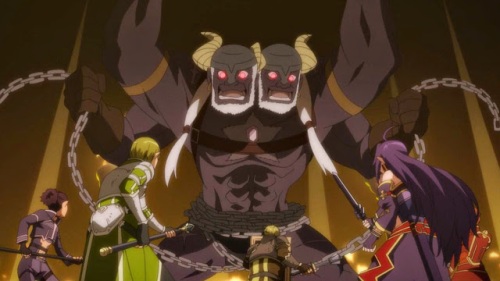
I thought that I could make it through this section without covering Kirito, but alas SAO II is so saturated (with more of the same Kirito viewers remember) that I can’t skip over him. His knack for problem solving and heroic nature is reinforced as Kirito puts his life on the line in the Phantom Bullet arc. While his character is more restricted by the game rules, he still manages to maximize his potential. For example: his weapon of choice, the lightsaber photon sword, isn’t frequently chosen by other GGO players. This gives him an edge, by making opponents struggle to counter the unfamiliar weapon. Similarly, the ‘real life’ Kazuto is the same intelligent, dedicated character viewers recognize, who puts his creative efforts toward VR technology. This not only gives his AI companion, Yui, a way to see the real world, but is used to help another character take an emotional journey as well.
By staying in this familiar realm, it limits how much Kirito adds to the story in terms of a compelling character arc. With the writers stuck in the same mode as season one, revolving the overall story around Kirito, the other characters don’t have much of an opportunity to shine. For example, Sinon’s trauma is overshadowed by a ‘similar,’ experience Kirito faced. Manufactured to show Sinon that she can also overcome her fears, Kirito’s story of ‘struggle’ felt painfully forced. Another missed opportunity for developing the other characters comes during the Mother’s Rosario arc. Despite Kirito being absent for most of these episodes, Asuna still ponders how her choices might affect him before making any decisions. Also, just when the audience begins to belive Yuuki’s skill rivals Kirito’s, the show drops hints to make viewers question her superiority. This is a narrative choice that I don’t really understand, especially in cases where using him weakens the plot.
Animation
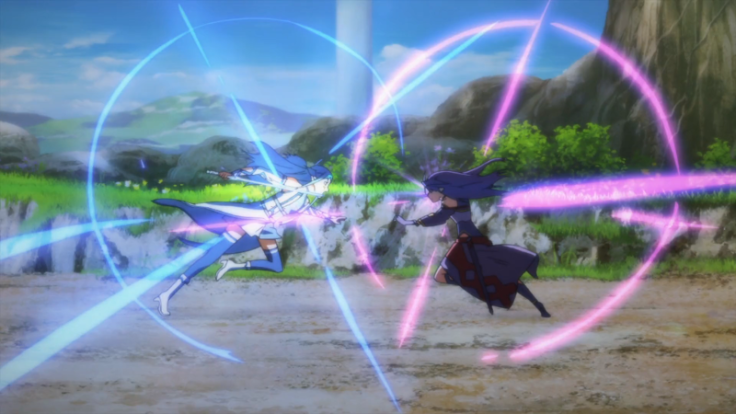
As the final series animated by A-1 Pictures that I watched this year, the quality and attention to detail present in their other work is on prominent display here as well. The technical improvements over the series’ predecessor are small, as it uses the same techniques for much of its combat and character animation. This method paid off well for the vibrant displays of SAO and work just as well the second time around.
The biggest difference comes in the design of the GGO world itself. The game has several different environments, but the one viewers are exposed to most resembles a post-apocalyptic city surrounded by desert. The abandoned look of the buildings and structures are quite different from the colorful environments of ALO, and convey the more gritty tone of the game. Damage effects have the same computerized look that they did in the previous games, but the physics of bullets and other firearms create added effects. Far from the simple bullet holes that one might expect, different types of guns are shown to have different effects. Sinon’s anti-material rifle in particular, the PGM Hécate II, looks incredible in action as it tears through whatever it hits, be it scenery or another player.

Character designs are a mixed bag, though they express the variety that the previous one did as well. The ALO designs have the same consideration for character personality that the Aincrad arc introduced, with Klein’s samurai gear carrying the most unique style. Kirito’s GGO avatar looks very much the same as his others, aside from a chest plate and feminine hairstyle. Death Gun looks decidedly grim, with features that seem to blend the mythical aspect of death with a modern feel. Sinon’s design is built with form in mind over function, with her shorts (if they can even be called that) resting so low that they require suspension from the rest of the outfit.
Of course, this is merely a part of the one facet in which the animators try to outdo themselves compared to the first series: the fanservice. Sinon spends a lot of time in the prone position as a sniper, and the series takes plenty of opportunities to focus on her backside. Even later on, as the story gets more serious, the unfortunate choice of camera angles leaves one to wonder what kind of story they’re trying to tell. I only wish that this was the worst that it got, but that honor belongs to a scene in which Kirito calls Asuna to invite her to go questing. For no other reason than to tease viewers, Asuna is taking a bath while this happens. Also, who sits in a tub like that?
Sound

OP1: IGNITE by Eir Aoi
OP2: Courage by Haruka Tomatsu
OP3: Separate Ways by Haruka Tomatsu
ED1: Startear by Luna Haruna
ED2: No More Time Machine by LiSA
ED3: Shirushi by LiSA
The singers used for the previous series returned to perform for SAO II, maintaining familiarity from a musical standpoint as well. IGNITE seems to best capture the same exciting feeling that Crossing Field did in SAO (though done by different artists). As for the other openings, I had written about my fondness for Haruka Tomatsu’s songs in earlier reviews and this series is no different. While Courage carries a lot of emotional tones for an opening, it has plenty of energy to make for a fitting theme to the Mother’s Rosario arc. The rest of the soundtrack reuses a lot of the more recognizable themes from SAO, keeping Yuki Kajiura’s well known style in the back of viewer’s minds.
Despite the existence of an English dub for this series, neither Netflix or Crunchyroll seemed to have it. This forced me to get a better sampling of the Japanese voices than I did the first time around. While the English voices weren’t bad, the original seiyuus seem to bring some special personality to their characters with their acting styles. Recalling Yoshitsugu Matsuoka from The Pet Girl of Sakurasou, I tried to picture Sorata whenever I heard Kirito, but there are enough differences to set them apart. Haruka Tomatsu’s Asuna sounds more similar to other roles she’s done, but suits the character’s personality. Aoi Yuuki, amusingly, played the part of Yuuki. Her exuberant performance surprised me, considering the only other role of hers I recognized was the deadpan Noël Kannagi from Sound of the Sky.
Overall Appeal
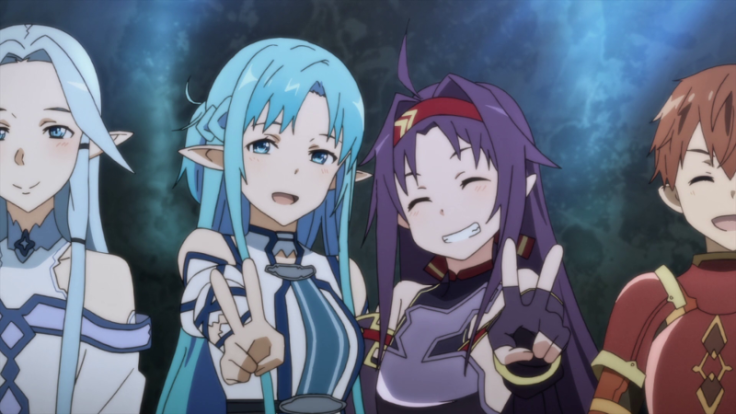
I could blow off this section by saying this series is just as much a love it or hate it anime as the original SAO, but that is being overly simplistic. SAO II had a number of elements that viewers might enjoy over the original series, but a number of drawbacks as well. Particularly, some argue that it offers much of the same experience as the first SAO series without adding anything substantial as a sequel.
Claiming that the series has no novel concepts isn’t entirely out of line, but it’s not a fair argument either. The Gun Gale Online game is a far cry from anything viewers were introduced to in SAO, changing the focus of the game to a better crafted PVP system than Fairy Dance featured. The mystery element of Death Gun’s identity and the reason he seems able to kill players in real life, creates an added layer of tension; even if viewers have a hard time buying the possibility of Kirito failing.
The entirety of SAO II also moves away from the idea of the game master as the villain, as well as limits the ways in which players can manipulate the game. By contrast, the game administrators in this series are either exceedingly difficult to reach (as seen in Phantom Bullet) or are otherwise inexplicably absent. This forces players to work within the confines of the game and its established mechanics to solve problems. Doing so reduces the chances of annoying deus ex machina elements, like those that capped the climactic moments of the first series, and helps make the characters’ successes more believable and noteworthy as a result.
The shortcomings are indeed similar to SAO in several ways, most notably with Kirito’s involvement. The series continues to assign skills and qualities to him as needed to overcome whatever problems he comes across. For example: viewers are expected to believe that criminal forensics cannot determine Death Gun’s method of killing his victims better than Kirito can within a few hours of playing a game. Or that his reaction time to the bullet lines is at a superhuman level simply because his time in SAO helped him hone his reflexes to such a degree. Or, worst of all, that he suddenly suffers PTSD from having to take a player’s life in SAO when it hardly bothered him at the time or ever since (again, just to be a ‘positive example’ for Sinon).

Mother’s Rosario remedies all this by the simple act of excluding Kirito. Yuuki’s character is similar sort of powerhouse, but one that is confined by the game in terms of ability. She cannot solo boss encounters despite her possessing a powerful sword skill, nor does her contribution far outweigh that of her teammates (compare to Kirito killing Gleam Eyes with dual wield alone). It is a refreshing change of pace as far as the character dynamics go, but it is far too short to be a prominent feature. In the interest of delivering a sentimental story, the arc ends up having to sacrifice both action and emotional impact. Had the series not spent three episodes on the inconsequential Calibur arc, there may have been more time to garner the sort of viewer investment needed for a story like this to work. As it is, it comes across as a set piece meant to illicit viewer sympathy without the proper character development to support it.
Summary and Recommendations
Sword Art Online II takes familiar elements from its prequel series and tosses them into unfamiliar territory. It introduces a new game, new challenges, and new friends through a series of three story arcs.
The Gun Gale Online game presents a departure from the fantasy elements of SAO, pitting players against one another in a hyper competitive environment. Mysterious player deaths spur Kirito into action, alongside the new player Sinon, to stop the murderer’s plot.
The series shows how the real life personas of many characters play into the motivations of their virtual counterparts, taking time to focus on what drives them personally and how they are compelled to seek an escape through VR games.
Much of the animation and music from the first series are brought back to deliver a cohesive experience across the two seasons. GGO provides interesting new visuals, but the impressive style and brings out the excitement of the series in its typical style.
The storytelling is more engaging and tense in this series, but still falls into the same pitfalls with an over-reliance on Kirito. His involvement in GGO overshadows the story set up around Sinon and he dominates the majority of the series going forward.
The final arc is an attempt to round out the story by including more real life concerns. Ultimately too short to make a definitive impact on the series, it shifts the focus toward Asuna and tells a poignant story about finding strength.
Watch if you:
Loved the first season of SAO
Appreciate stories with less action
Want more characters than just Kirito
Don’t watch if you:
Think this impoves vastly over SAO
Prefer Kirito to be invincible
Are averse to blatant fanservice
My Rating
This series introduces some small improvements over its predecessor while suffering many of the same flaws. My rating is 3.5 out of 5 Kiritos.

Final Thoughts
Whatever your individual feelings in the series are, the Sword Art franchise offered brought something special to the anime world. Its premise and approach to exploring its stories were enjoyable for many people due to a number of facets, including: An epic story, the nature of VR in relation to the real world, elements of MMORPGs, and strong character focus. Among the series’ issues, however, is its inability to get all cylinders firing at once. To get an idea of what I mean, look at the below graphic.
The columns for the table are defined as follows:
Epic Story – The story is large in scale and gives the sense of wide involvement
Real World vs VR – The story explores the parallels between the real and virtual worlds.
Feels like a MMO – Many different characters are able to influence the story and events.
Compelling character arc – The story is about one or more interesting characters
Doesn’t revolve around Kirito – A purely snarky category. Ignore it if you liked Kirito.
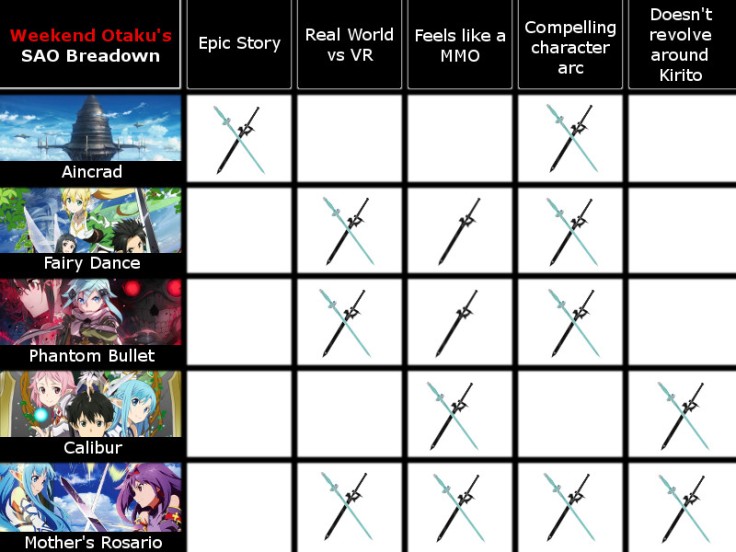
The Aincrad arc is a favorite of many SAO fans, particularly because it nails that first point. The story is convincingly grand, setting up a widespread world with thousands of people involved, but gives the viewers something to grasp onto by following its main character: Kirito. As the graph shows, no other arc seemed to capture this same feeling, which makes Aincrad stand out as the most iconic SAO story. Kirito’s solo act and the separation between the game and real life make it miss the other points.
Fairy Dance, and every arc after it aside from Calibur, hits the Real World vs VR theme nicely by introducing real life problems that manifest in game. Likewise, the characters introduced (Suguha, Shino, and Yuuki) have interesting stories for viewers to follow. It also starts a trend where the writers make the game feel more like a MMO, with various players able to affect the outcome of the games. Still, I would I consider both Fairy Dance and Phantom Bullet half measures here, since the other players’ involvment was light. Sadly, this is the only part that Calibur really gets right, but at least it does so better than any of the previous arcs.
Mother’s Rosario stands out for being thematically different from the rest of the series, as its entire premise was in relation to the concept of Reality vs VR. The MMO aspect was clearly present with the goal that the Sleeping Knights were working towards, and we got interesting stories for both Asuna and Yuuki, however brief they were. In my judgement, it was easily the best arc out of them all. If it had been given 14 episodes, like the Aincrad and Phantom Bullet arcs before it, it might have been an incredible story.
I have had mixed feelings about SAO many times, both during and after its run, but I found myself continuing to give it more chances. Much as I complain about certain aspects of the franchise, I really would have loved to see a story that hits all the checkboxes I mentioned. If the final arc is any indication, this is something that they steadily improved upon. With a film coming out soon, there is a chance at getting a ‘perfect’ story just yet. I might not love it, given SAO‘s track record, but I will probably watch either way.
More Reviews
Can resist reading more opinions on SAO? Check out these articles from other great bloggers:
Chibi Reviews: Sword Art Online II by RailgunFan75
A great, short, spoiler free review that gives overview of the major points of the series and breaks down the pros and cons.
Sword Art Online II Review by Dreager1
A look at where the series fell short, from the point of view of someone who liked having Kirito has the main star.
Sword Art Online II: In a future where actual murderers are readily released by Ktulu
For contrast, some perspective from someone who finds the main duo to be less than exciting characters.
For more from me, you can find my other reviews on my Reviews Page or click on the tags below to see posts on similar shows. As always, thank you for reading.

An excellent and very fair review of a series I really enjoyed overall.
I especially liked how you broke down each of the arcs at the end with the swords chart.
LikeLiked by 2 people
Thank you for reading and for the compliment! I didn’t know how well that chart would go over, so I’m glad you thought it was a good addition.
LikeLiked by 2 people
I feel I have to watch this show just so I can see why it’s so polarizing. Plus, a Yuki Kajiura soundtrack is always worth watching a show for imo.
LikeLiked by 2 people
Haha, we all start that way, Crystal!
A lot of the themes are pretty great, so yeah, you pretty much can’t go wrong when she’s involved.
LikeLiked by 1 person
A great review and fair amount of criticism… Everything said about the Mother’s Rosario arc was acceptable, including the part about her mother being scarier. I was scared of her when she actually pulled the power chord 😕.
I saw SAO on a stretch, 1 and 2 combined, so never felt that it was like a sequel. It should have had something more when coming to a sequel, but I enjoyed it anyway when I thought both the series are the same lol 😁
LikeLiked by 1 person
That’s a lot of SAO to watch at once! There was a lot about this series that I liked too, and things that bugged me… In that sense it feels just like the first SAO for me as well!
You mentioned you were looking forward to this one, so thanks for reading. Hard at work on the next already!
LikeLike
Yep I was totally looking forward to it and it was unbiased and clean a review..
If my guess is correct next one is Nagi no Asukara? I have said already but I do expect another clean and great review for this on too from you 😁 great job ✌
LikeLiked by 1 person
Yes, good guess 🙂 Hopefully I can do it justice since there was a lot they packed into that show, but I always appreciate the encouragement.
LikeLiked by 1 person
Ah…..Sword Art Online. Ah show I really love. I cannot even explain exactly why, but it has really become one of my favorite Anime series to date. I am in the minority here, but I actually like the second season better than the first season (although a friend of mine felt the same). The first arc of the 2nd season felt really dark, and was more tense and gripping than anything that came before it. The second half, though not perfect, also had some great moments, abd even though she was only in it for a short while I quite liked Yuuki. (And Sinon ofcourse was really cool). All in all I can’t wait for the movie next year, and where the story will take us next. Great review as always, and I really liked the chart you put at the bottom of this review: very original and a great concept. 😀
LikeLiked by 1 person
Well a lot of SAO fans just really fell in love with that very first arc, so when things start to go differently, they lose interest. I’m with you on liking the second season better, though. I liked a certain 7 episodes better than all of it 😉 but yes, Phantom Bullet was a nice attempt at tension and I really appreciate that they tried to do something different instead of being formulaic.
Thank you very much for reading. I always look forward to discussing with you!
LikeLike
I can’t explain it but the GGO arc was my fave-maybe it was seeing kirito as a girl instead of having his harem around him or Maybe because sinon is my favorite SAO character of them all. Overall great review with great criticisms I also really enjoyed that graphic chart with the swords!
LikeLiked by 1 person
Thank you so much for reading and for your comments 🙂
Even I’m a bit warmer toward GGO since I wrote this. I blame Cain for that. Sinon was a good character, I just wish I saw more of her story than I saw of her rear. But I’m glad you liked the chart! I figured it summed up my experience with the franchise pretty well.
LikeLiked by 1 person
I did say I may spam you today! haha! Yes I would agree on that! She would’ve been good for story if not just fan service.
LikeLiked by 1 person
Oh, spam all you want. Seeing people get something out of reading these is great.
LikeLiked by 1 person